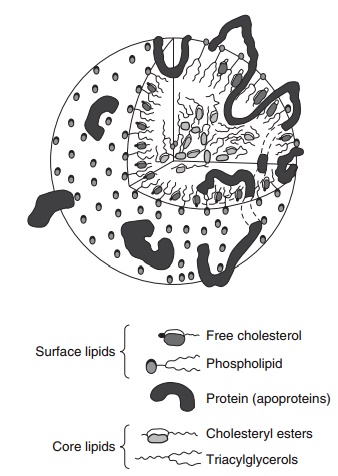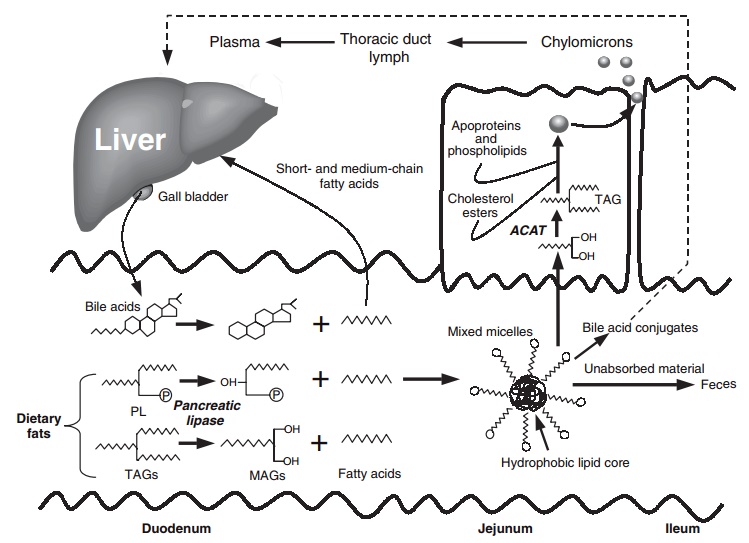Chapter: Introduction to Human Nutrition: Nutrition and Metabolism of Lipids
Solubilization of emulsified fat
Solubilization of emulsified fat
Fats are insoluble in water and must be rendered soluble before they can be absorbed in the gut and transported within cells and in the circula-tion. In each of these situations, this is achieved by the hydrophobic fat or lipid associating with mole-cules that are capable of interfacing with both hydro-phobic and hydrophilic environments. Molecules with these characteristics are called amphipathic mol-ecules, examples of which are phospholipids, bile salts, and specialized proteins known as apoproteins (Figure 6.5). In the small intestine emulsified fats are solubilized by associating with bile salts produced in the liver and stored and released from the gallbladder, and phospholipids to form complex aggregates known as mixed micelles. Lipids within cells and in the cir-culation are solubilized by combining with specific proteins known as fatty acid-binding proteins (FABPs) and apolipoproteins (ApoA, B, C, E), respectively.

Figure 6.5 General lipoprotein structure. (Reproduced from Dur-rington PN. Hyperlipidaemia Diagnosis and Management, 2nd edn. Elsevier Science, Oxford, copyright 1995 with permission of Elsevier.)
The action of pancreatic lipase on TAG yields free fatty acids and 2-MAG. Fatty acids of short- and medium-chain length (≤14 carbons) are absorbed directly into the portal circulation with free glycerol and transported bound to albumin to the liver, where they are rapidly oxidized. In contrast, long-chain fatty acids (LCFAs; >14 carbons) associate with bile salts in bile juice from the gallbladder and are absorbed into the enterocyte for further processing and packaging into transport lipoproteins. The primary bile salts, cholic and chenodeoxycholic acids, are produced from cholesterol in the liver under the action of the rate-limiting enzyme 7-α-hydroxylase. These bile salts act effectively as detergents, solubilizing lipids by the formation of mixed micelles. These are spherical associations of amphipathic molecules (with hydro-phobic and hydrophilic regions) with a hydrophilic surface of bile salts and phospholipids that encapsu-lates a hydrophobic core of more insoluble LCFAs and 2-MAG (see Figure 6.4). The micelle core will also contain some lipid-soluble vitamins including tocopherols and carotenoids. The formation of mixed

Figure 6.4 Reception, emulsification, lipolysis, solubilization, and absorption of fats. ACAT, acyl-CoA-cholesterol acyltransferase; MAG, mono-acylglycerol; TAG, triacylglycerol; PL phospholipid; P, phosphate.
micelles increases the solubility of fat by 100- to 1000-fold. They create an acidic microenvironment for the lipid core which, through protonation, facilitates the dissociation of LCFAs and 2-MAG from the micelle and diffusion into the enterocyte.
Related Topics